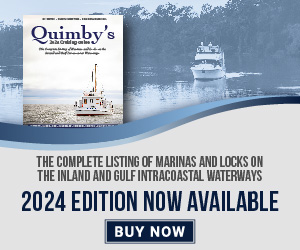No Impact From Tariffs Yet, Ship Pilots Say
Pilots from two state pilot associations said they have not seen any reduction in the number of foreign ship calls on the Lower Mississippi River since the Trump administration began putting pressure on the United States’ trading partners.
Capt. Stephen Hathorn of the New Orleans/Baton Rouge Steamship Pilots Association (NOBRA) and Capt. Mike Popp of the Crescent River Port Pilots Association both said foreign-flag ship calls have remained steady in recent months.
“Tariffs haven’t affected ship calls at all, but we’re keeping our eye on it,” Hathorn told the Greater New Orleans Port Safety Council (GNOPSC) meeting held July 11 at the Southern Yacht Club. More than 80 industry representatives attended.
Pilots from NOBRA guide ships from New Orleans to Baton Rouge, approximately Mile 93 AHP (Above Head of Passes) in New Orleans to Mile 236 AHP in Baton Rouge, where deep water ends and only shallower-draft barge traffic continues upriver.
“Traditionally, we saw a 30 to 40 percent reduction of vessel traffic in the summer months, but we haven’t seen that since Hurricane Katrina in 2005,” he added.
“China has a lot of people, and they need to eat,” Popp added. Any grain customers who took their business to Argentina will probably be returning, because “Argentina had a terrible year” harvesting crops, he explained.
Crescent pilots guide ships from Pilottown, about Mile 12 AHP, to New Orleans. Large grain elevators for loading ships are situated in both Crescent and NOBRA sections of the Mississippi River. Mostly the grain is transported to the elevators from the Midwest by covered hopper barges.
Popp said there is an effort being proposed by Ports America to build new docks for container ships in the vicinity of Meraux, about 10 miles downriver from New Orleans. Including needed infrastructure, building those docks for ships approaching 1,200 feet in length could reach $1 billion, he said.
Driving that consideration is the air draft restrictions that would affect ever-larger container ships by the Crescent City Connection bridges crossing the river below the existing Nashville Avenue container docks.
Another project under consideration is a proposal to bring large Aframax class ships to Chevron’s dock in Empire, La., about Mile 27.
“We haven’t seen ships at Chevron Empire in 15 years,” Hathorn said.
Corps Supplemental Funding
The Corps of Engineers has received $1.3 billion in supplemental funding for authorized construction projects, said Mike Park, operations chief for the New Orleans Engineer District.
Much of the supplemental funding will be directed for flood reduction projects in the New Orleans District with the Corps currently working on four projects, he said.
Upcoming dredging projects will include a cutterhead dredge operating at the Port of New Orleans and using the Corps’ dredge Wheeler at Southwest Pass. Three dustpan dredges are currently working in the crossings between New Orleans and Baton Rouge.
Sean Duffy, who directs the Big River Coalition for the Louisiana Maritime Association and industry partners, said he just received a report that is encouraging the deepening of the Lower Mississippi River from 45 to 50 feet.
According to the report by the Soy Transportation Coalition (WJ, July 16) deepening the Mississippi River Ship Channel an extra 5 feet would reduce transportation costs on soybean cargoes by 13 cents per bushel and save shippers $5 per metric ton, Duffy noted.
The Corps’ General Reevaluation Report draft indicated a benefit/cost ratio 7.2:1, which he said is “very strong and should get funded.”
The 30-day public comment period just concluded, he said, adding the final report will be produced as a Director’s Report, which should be signed by the end of July.
Duffy will be attending the Ag Transportation Summit of the National Grain & Feed Association later this month and hopes to have the new Director’s Report in time to be able to explain the cost savings with a presentation there.
Shipping and farming interests need to be more active in encouraging the administration and Congress to fund the project, he said, adding the Corps could see some funding as early as Fiscal Year 2019 or 2020. Both federal and state funding is needed for the river deepening.
Louisiana Rep. Mark Wright, a first-term state legislator and former American Waterways Operators vice president, said Louisiana could face more “financial cliffs” in state funding, and he encouraged industry representatives to educate lawmakers on the value of waterways, which would help promote needed funding.
Also attending was Capt. Kristi Luttrell, newly installed commander of Coast Guard Sector New Orleans, who introduced members of her staff. Luttrell previously served as deputy sector commander and developed a close working relationship with industry representatives.
The Coast Guard recently worked with the Jefferson Parish Fire Department and the Port of New Orleans fireboat to successfully extinguish a fire on a barge loaded with crushed automobiles (WJ, July 2). Luttrell said lessons learned will be discussed in an upcoming “hot wash.”
The GNOPSC is an integral part of local maritime operations in which the Coast Guard, Corps, Customs and Border Patrol, pilots associations and industry representatives exchange information and best practices, said chairman Marc Hebert, a senior partner at the Jones Walker law firm.



